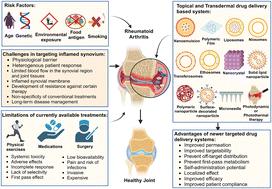Our official English website, www.x-mol.net, welcomes your
feedback! (Note: you will need to create a separate account there.)
Revolutionizing rheumatoid arthritis treatment with emerging cutaneous drug delivery systems: overcoming the challenges and paving the way forward
Nanoscale ( IF 5.8 ) Pub Date : 2024-11-19 , DOI: 10.1039/d4nr03611e Sakshi Priya, Kaushal Kailash Jain, Jeevika Daryani, Vaibhavi Meghraj Desai, Himanshu Kathuria, Gautam Singhvi
Nanoscale ( IF 5.8 ) Pub Date : 2024-11-19 , DOI: 10.1039/d4nr03611e Sakshi Priya, Kaushal Kailash Jain, Jeevika Daryani, Vaibhavi Meghraj Desai, Himanshu Kathuria, Gautam Singhvi

|
Rheumatoid arthritis (RA) is a chronic inflammatory disorder of the articulating joints. Though considerable progress has been made in understanding the disease in the past 50 years, its pathogenesis remains unclear. The therapies for RA, such as nonsteroidal anti-inflammatory drugs, disease-modifying antirheumatic drugs, and glucocorticoids through conventional therapeutic delivery systems by percutaneous, intra-articular, intraperitoneal, oral, and intravenous administration, have shown their own disadvantages, which eventually reduce patient compliance for long-term therapy. Recently, drug delivery via a topical or transdermal route has gained attention as an alternative to the conventional approach. Though skin acts as a barrier for the delivery of drugs due to its structure, various permeation pathways are manipulated to enhance the drug delivery across or into the skin. However, poor skin retention is the reason for the failure of many conventional topical dosage forms, such as gels, sprays, and creams. Hence, there is an urgent need for conquering the skin boundary to improve skin partitioning. Nanotechnology is a developing and dynamic field gaining popularity in the nanoscale design. This review extensively describes the potential of various nanoformulations, such as vesicular systems, lipid nanoparticles, and polymeric nanoparticles, with a targeted approach to deliver the drugs to the inflamed joint region. Limelight has also been provided to next-generation approaches like surface modification, stimuli-responsive formulations, multifunctional carrier systems, microneedles, and microsponge systems. Physical methods for enhancing the transdermal delivery, such as electroporation and sonophoresis, and emerging treatment therapies, such as gene therapy, photothermal therapy, and photodynamic therapy, have been evaluated to enhance the treatment efficacy. The clinical status, patents and current challenges associated with nanotechnology and the future prospects of targeted drug delivery have also been discussed.
中文翻译:

使用新兴的皮肤药物输送系统彻底改变类风湿关节炎治疗:克服挑战,铺平前进之路
类风湿性关节炎 (RA) 是一种关节的慢性炎症性疾病。尽管在过去 50 年中,人们对这种疾病的了解取得了相当大的进展,但其发病机制仍不清楚。通过经皮、关节内、腹膜内、口服和静脉给药的常规治疗递送系统对 RA 的治疗,如非甾体抗炎药、改善病情的抗风湿药和糖皮质激素,显示出其自身的缺点,最终降低了患者对长期治疗的依从性。最近,通过局部或透皮途径给药作为传统方法的替代方案而受到关注。尽管皮肤由于其结构而充当药物输送的屏障,但各种渗透途径纵以增强药物穿过或进入皮肤的输送。然而,皮肤保留不良是许多常规外用剂型失败的原因,例如凝胶、喷雾剂和乳膏。因此,迫切需要征服皮肤边界以改善皮肤分割。纳米技术是一个不断发展的动态领域,在纳米级设计中越来越受欢迎。本综述广泛描述了各种纳米制剂的潜力,例如囊泡系统、脂质纳米颗粒和聚合物纳米颗粒,并有针对性地将药物输送到发炎的关节区域。下一代方法也受到了关注,如表面改性、刺激响应配方、多功能载体系统、微针和微海绵系统。 已经评估了增强透皮给药的物理方法,例如电穿孔和超声电渗疗法,以及新兴的治疗疗法,例如基因疗法、光热疗法和光动力疗法,以提高治疗效果。还讨论了与纳米技术相关的临床现状、专利和当前挑战以及靶向药物递送的未来前景。
更新日期:2024-11-19
中文翻译:

使用新兴的皮肤药物输送系统彻底改变类风湿关节炎治疗:克服挑战,铺平前进之路
类风湿性关节炎 (RA) 是一种关节的慢性炎症性疾病。尽管在过去 50 年中,人们对这种疾病的了解取得了相当大的进展,但其发病机制仍不清楚。通过经皮、关节内、腹膜内、口服和静脉给药的常规治疗递送系统对 RA 的治疗,如非甾体抗炎药、改善病情的抗风湿药和糖皮质激素,显示出其自身的缺点,最终降低了患者对长期治疗的依从性。最近,通过局部或透皮途径给药作为传统方法的替代方案而受到关注。尽管皮肤由于其结构而充当药物输送的屏障,但各种渗透途径纵以增强药物穿过或进入皮肤的输送。然而,皮肤保留不良是许多常规外用剂型失败的原因,例如凝胶、喷雾剂和乳膏。因此,迫切需要征服皮肤边界以改善皮肤分割。纳米技术是一个不断发展的动态领域,在纳米级设计中越来越受欢迎。本综述广泛描述了各种纳米制剂的潜力,例如囊泡系统、脂质纳米颗粒和聚合物纳米颗粒,并有针对性地将药物输送到发炎的关节区域。下一代方法也受到了关注,如表面改性、刺激响应配方、多功能载体系统、微针和微海绵系统。 已经评估了增强透皮给药的物理方法,例如电穿孔和超声电渗疗法,以及新兴的治疗疗法,例如基因疗法、光热疗法和光动力疗法,以提高治疗效果。还讨论了与纳米技术相关的临床现状、专利和当前挑战以及靶向药物递送的未来前景。


















































 京公网安备 11010802027423号
京公网安备 11010802027423号